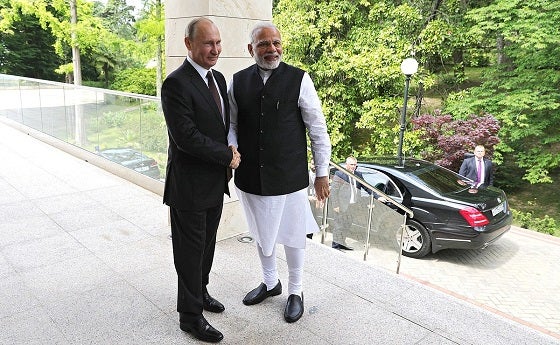Summary
Although India under Prime Minister Narendra Modi has embraced the Indo-Pacific construct promoted by the United States and has actively engaged with the Quadrilateral mechanism involving Japan and Australia, New Delhi is not hostile to the idea of Eurasia. It is determined to carve out a role for itself in Eurasia in partnership with Russia.
Having recently come to terms with the new geopolitical conception of the Indo-Pacific, India is eager to step up its engagement with Eurasia. New Delhi is determined to look beyond the apparent tension between the ideas of the Indo-Pacific and Eurasia and strengthen its continental position in a deeper partnership with Russia.
The strategy of continentalism has been associated with land-based powers like Germany and Russia, while Great Britain and the United States have long relied on maritime strategies for their global influence. The current Indo-Pacific project has been championed by maritime states like Japan and the United States and embraced by Australia and Indonesia, whose geography is essentially maritime.
China has traditionally been a land power that is seeking to expand its influence across the Pacific and Indian Oceans. Beijing suspects that the Indo-Pacific project is about limiting its possibilities in the maritime domain. China’s own Belt and Road Initiative (BRI) has both continental and maritime dimensions. The Silk Road Industrial Belt is about expanding China’s connectivity all across the inner Asian land mass and reaching out to Europe.
The 21st century Maritime Silk Road is about connecting China’s industrial heartland in the east to markets in Southeast Asia and the Indian Ocean littoral. It is also seen as one aspect of China’s ambition to project its military power into the far seas of the Pacific and Indian Oceans. As a great trading nation and the world’s second largest economy, China’s ambitions are both continental and maritime.
India’s interests too are at once continental and maritime. Modern India was once the object and driver of European maritime expansion in the colonial era. After its independence, India turned inward and focused on consolidating its territorial state in the subcontinent. Its security challenges too were largely continental as it battled to stabilize the post-partition boundary with Pakistan and confronted Chinese expansion into the Himalayas. As the Indian economy opened up to the world and trade became an important new element of India’s commercial profile, its interest in maritime affairs has received a strong boost.
India’s twin orientation is reflected in the fact that it is part of both the Shanghai Cooperation Organisation (SCO) that was constructed by China and Russia at the turn of the millennium and the Indo-Pacific Quad that was launched in the first decade of the 21st century. Many analysts see India’s engagement with the continental and maritime coalitions as riddled with contradictions and unsustainable.
As New Delhi persists in the engagement with both the groupings, the fear of conflict breaking out between the two coalitions has yielded to more complex equations. A number of recent developments point to the blurring of boundaries between the strategic conceptions of Eurasia and the Indo-Pacific.
For example, Singapore has signed a free trade agreement in September 2019 with the Eurasian Economic Union (EAEU) that brings Russia into a loose community with four former Soviet republics – Belarus, Armenia, Kazakhstan and Kyrgyzstan. Singapore is not the first country from the Pacific to sign such an agreement with the EAEU. Vietnam signed a similar agreement in 2015.
Japan on its part has long sought to break through the logjam in East-West relations by exploring the possibilities for a rapprochement with Russia. Now France has joined the quest. In his address to the French diplomats in August 2019, French President Emmanuel Macron underlined the importance of engaging Russia to cope with the rise of China and the growing uncertainty in America’s global trajectory.
French concerns about the emerging challenges from a rising China are widely shared in Europe. Troubled by China’s swift penetration of eastern and central Europe through the BRI, the European Union has come up with its own strategy for connectivity and is stepping up the engagement with Japan, the Association of South East Asian Nations (ASEAN) and India.
Meanwhile, Russia is no longer satisfied with merely being a continental power. It is eager to overcome some of its geographical constraints and is seeking a larger role in the Pacific. Its recent initiatives like the Far Eastern Economic Forum and its planned summit with the African nations are about seeking a wider footprint beyond Eurasia.
Although China has become the most important partner for Russia over the last decade, Moscow has no desire to play Beijing’s second fiddle forever. This in turn has given New Delhi the space to step up security, economic and political engagement with Russia, often in defiance of the United States’ threat of sanctions.
Given India’s own geographic limitations, especially the lack of direct overland access to Eurasia, India has depended on Russia to enhance its regional profile. Moscow’s support was crucial in New Delhi gaining the membership of the SCO. India has sought to develop the Eurasian transport corridor in partnership with Russia, Iran and the Cental Asian republics over the last many years. During his visit to Vladivostok in September 2019, Modi announced the setting up of a maritime corridor between Chennai and Vladivostok.
As the great power relations enter a period of churn, the traditional frameworks that have guided 20th century strategic discourse are breaking down. Keeping the Russia option open amid considerable difficulties that emerged in the bilateral relationship might well turn out to be a wise decision for New Delhi.
….
Professor C. Raja Mohan is Director at the Institute of South Asian Studies (ISAS), an autonomous research institute at the National University of Singapore (NUS). He can be contacted at crmohan@nus.edu.sg. The author bears full responsibility for the facts cited and opinions expressed in this paper.
-
 More From :
More From :
-
 Tags :
Tags :
-
 Download PDF
Download PDF



